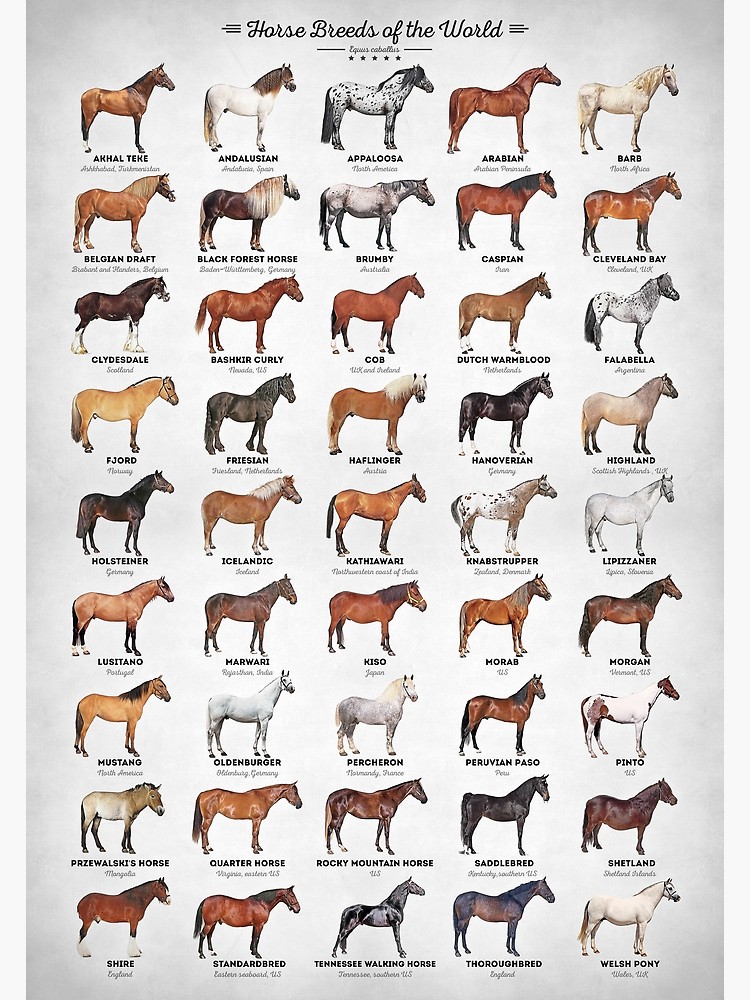When it comes to horses, we all have our preferences, whether we prefer a certain look or a particular function, and for some people it’s just a perceived connection. Some folks “feel” like they really connected with a particular horse because of its approach when they first encountered it. Whatever your reason for selecting a particular breed the horse probably needs to be trained, if you’re planning to do something with it. There really is no “breed specific training” although there may be breeds that are better suited to certain tasks than other breeds.
Some folks might just want a pretty horse to hang out in the pasture so they can admire the elegance and beauty of its movement. Be it the stoic, bold, appearance of the draft breeds or the flighty majesty of the Arabians – or just about anything in between. Horses have been purpose bred for many centuries, selective breeding has created the range of breeds and the variety of phenotypes that we see today. Breeding has also resulted in a more or less predictable attitude from the energetic “hot bloods” (usually Arabians and Thoroughbreds – bred for speed and explosiveness) through the “warmbloods” (typically stock horses and sport horses) and on to the “cold blooded” (heavy draft horse) type.
From my observations the approach to training a horse regardless of breed consists of a range of similar or identical fundamentals. For example, you must be able to motivate the horse to move, in order to be able to direct its feet, you must be able to stop the horse – and it will not matter what breed you are dealing with, these goals are identical. How you go about achieving them may change and be dictated by a variety of factors including breed, environment, previous handling and by the horse’s own personality. As a trainer you must be mentally flexible and willing to change or alter your approach to training based depending on all of these factors.
Ironically while we always tend to think of the big strong draft breeds as docile, they too have different challenges to handling than flighty hot bloods. It surprises some folks to learn that drafts are often bred into bucking horses because of their size and power. Drafts are as intelligent as any other horse, but their docile nature makes them challenging to motivate and move around, by contrast, Arabians are usually pretty eager to get their feet moving and go someplace. When you enter the round pen with a draft he may just stand still or meander around and require a lot of motivation to get moving, making it hard to direct his feet. It is always easier to direct the feet of a horse that is easy to move, and Arab or thoroughbred for instance. The warmbloods generally have more balanced characteristics which make them easier to motivate than a draft and less inclined to explode into action than a hot blood although capable of either behaviour. It is that balance and easy-going nature that makes the warmbloods so popular.
The thing that has to change with training different is the attitude of the trainer, a draft horse may need more energy from the trainer to motivate movement but when that same level of energy is bought to the, hot-blooded, Arabian you may need to collect him from the next county. The Arabian is a more sensitive animal and requires less energy to motivate since he is already halfway to moving anyway. Horses aren’t necessarily “easier” to train by breed, but breed characteristics do play into the general type of response of behaviour you might anticipate from that breed. When buying a horse ease of training should be a consideration, after all if you plan to ride or work your horse you will need to be able to get along with it. Consider your intended use. A horse from draft lines may be perfectly fine for your kids to jump all over where a hot-blooded type might not, they may be too sensitive. You may like the big bouncy step of the draft, but he isn’t going to be racing around barrels.
Sensitivity to movement is important to horse trainers, without movement it’s hard to direct, but so is the ability to stand still for grooming or for the farrier. If you are a beginner or less experienced rider the hot-blooded horse, probably is not be for you, a light touch of the leg and they are running. The quarter horse, a warmblood, is one of the most popular breeds in the world, they are also the fastest breed – but not all quarter horses are fast. Quarter horses are still used as work horses for both riding and light carriage work and there is tremendous diversity in type within the breed from the little downhill reining or cutting horses to the larger, sturdier, work all day, ranch horses and on up to the leggy racing horses that hold the speed titles. Quarter horse history is fairly recent and the Quarter horse probably owes most of its refinement to the thoroughbred which explains why quarter horse and thoroughbred mixes can be registered with the American Quarter Horse Association on the Appendix Registry.
It is also important when discussing training to recognize that once you start handling, riding or driving a horse you are constantly training the horse either deliberately or by inadvertence, which is why a lot of people have difficulty with their horses. We sometimes reward undesirable behaviour and reinforce its emergence. Most of the equestrians I know are recreational riders, they want to go out and ride their horse for fun or pleasure and they are not particularly students of the horse. Some people love to do one specific thing with their horse, maybe it’s run around barrels, western pleasure or trail or other work like trail riding. Whatever your desire, it is important to get the right breed of horse for the task.

